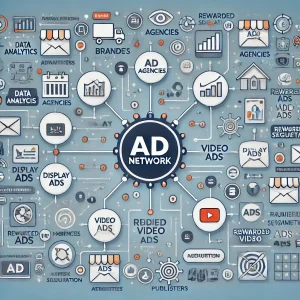Ad Networks and their Role in the Ad Ecosystem
Ad networks are key players in the digital advertising ecosystem. They serve as intermediaries between advertisers and publishers, facilitating the buying and selling of ad space. In the complex ad ecosystem, ad networks help advertisers reach target audiences and enable publishers to monetize their content effectively.
Ad networks aggregate ad inventory from multiple publishers, creating a vast pool of available ad space. They then offer this aggregated inventory to advertisers, simplifying the ad buying process. By doing so, they help bridge the gap between supply (publishers) and demand (advertisers), making the entire ad monetization process more efficient.
Understanding ad networks is essential for both advertisers and publishers. For advertisers, ad networks provide a single point of access to a large number of websites and apps, reducing the need for direct deals. For publishers, they offer a streamlined way to monetize unsold inventory, optimizing ad revenue. In an ever-evolving digital landscape, knowing how ad networks function and fit into the broader ad ecosystem can lead to more effective ad monetization strategies and better outcomes.
[ez-toc]
Contents
How Ad Networks Operate
Ad networks operate through a series of well-defined processes that enable efficient ad inventory management and targeted ad delivery. The primary operations include inventory aggregation, ad matching, placement, and delivery. Let’s explore each step in detail:
- Inventory Aggregation and Selling: Ad networks collect ad inventory from multiple publishers, including websites, apps, and other digital platforms. This inventory comprises various ad formats such as display ads, video ads, and rewarded video ads. By pooling ad space from different sources, ad networks create a large inventory pool that advertisers can access. This aggregation benefits both advertisers and publishers. Advertisers gain access to a wide range of ad placements, while publishers can sell their ad inventory more efficiently.
- Matching Advertisers and Publishers: Once the inventory is aggregated, ad networks use sophisticated algorithms to match ads with available spaces based on targeting criteria such as user demographics, interests, browsing behavior, and geographic location. This process is crucial for maximizing ad effectiveness. For example, an advertiser promoting a new mobile game would want their ad displayed to users who frequently engage with gaming content. Ad networks use data analytics to ensure that ads reach the most relevant audiences, enhancing engagement rates and driving higher ROI.
- Ad Placement and Delivery: Ad networks manage the actual placement and delivery of ads across various platforms. This step involves serving ads to users as they browse websites, use apps, or engage with digital content. Ad networks rely on data analytics and audience segmentation to deliver ads to the right users at the right time. This data-driven approach ensures that ads are seen by users most likely to engage with them, increasing click-through rates (CTR) and conversion rates. Effective ad placement and delivery are key to optimizing ad campaigns and maximizing revenue.
Types of Ad Networks
 Ad networks vary in their focus and specialization. Understanding the different types of ad networks can help advertisers and publishers choose the right partners for their specific needs:
Ad networks vary in their focus and specialization. Understanding the different types of ad networks can help advertisers and publishers choose the right partners for their specific needs:
- Vertical Networks: Vertical ad networks specialize in specific industries or niches, such as automotive, healthcare, finance, or gaming. For example, a vertical network in the gaming industry may offer ad placements exclusively on gaming websites and apps. This specialization allows advertisers to reach highly targeted audiences within a particular sector, ensuring higher relevance and engagement. Vertical networks are ideal for advertisers looking to penetrate niche markets and for publishers who want to attract advertisers within their industry.
- Blind Networks: Blind ad networks offer low-cost inventory but with limited targeting capabilities. These networks often provide less transparency to advertisers regarding where their ads will appear. As a result, advertisers may have less control over brand placement, which can affect brand safety. However, blind networks are cost-effective for advertisers looking to reach broad audiences without the need for precise targeting. They are often used for high-volume, low-cost campaigns that prioritize reach over specific audience targeting.
- Premium Networks: Premium ad networks deal with high-quality inventory, providing advertisers with more control and transparency over where their ads are displayed. These networks focus on reputable sites that offer high visibility and engagement. Advertisers can choose specific publishers or types of content for their ads, ensuring brand safety and better campaign performance. Premium networks are ideal for advertisers who prioritize quality over quantity and are willing to pay higher rates for premium placements. Publishers benefit by attracting high-value advertisers, which can lead to higher revenue.
Benefits of Using Ad Networks
Ad networks offer several advantages for advertisers, publishers, and the broader ad ecosystem. These benefits help streamline ad buying and selling, optimize ad monetization, and improve overall campaign performance:
- For Advertisers:
- Scalability and Reach: Ad networks enable advertisers to reach large audiences across multiple publishers with a single platform. This scalability helps advertisers expand their reach and increase brand visibility without negotiating with individual publishers.
- Efficiency and Cost-Effectiveness: Ad networks simplify the process of buying ad space, reducing the time and effort needed to manage multiple ad deals. They often use competitive pricing models like CPC (Cost Per Click) and CPM (Cost Per Thousand Impressions), allowing advertisers to control costs and optimize ad spend.
- Targeting Options: Ad networks offer advanced targeting options, including demographic, geographic, and behavioral targeting. These options enable advertisers to reach their desired audience with precision, improving engagement and conversion rates.
- For Publishers:
- Monetization of Remnant Inventory: Ad networks help publishers monetize unsold ad space that might otherwise go unused. This enables publishers to maximize revenue and improve ad monetization strategies by filling all available inventory.
- Revenue Optimization: By accessing a broader pool of advertisers, publishers can drive up competition for their ad space, resulting in higher eCPMs (effective cost per thousand impressions) and better revenue optimization. This is particularly beneficial for websites and apps with high traffic but fluctuating demand from direct advertisers.
- For the Ecosystem:
- Simplifies the Process: Ad networks act as intermediaries, reducing the complexity of direct deals between advertisers and publishers. This simplification helps streamline ad transactions, making the ad monetization process more efficient.
- Data Insights and Analytics: Ad networks provide detailed reporting and analytics, offering valuable insights into ad performance. This data helps both advertisers and publishers optimize their strategies for better results. For example, advertisers can refine targeting based on performance data, while publishers can adjust their ad placements to improve user experience and increase engagement.
Challenges Associated with Ad Networks
Despite their benefits, ad networks also present challenges that advertisers and publishers must navigate:
- Transparency Issues: Ad networks often provide limited transparency regarding where ads are displayed. This lack of visibility can impact brand safety, as ads may appear on websites or apps that do not align with the advertiser’s brand values. To mitigate this, advertisers should choose premium networks that offer more control and transparency.
- Ad Fraud: Ad networks face a higher risk of fraudulent activities, such as click fraud, fake impressions, and bot traffic. These activities can lead to wasted ad spend and reduced campaign effectiveness. To combat ad fraud, advertisers should work with reputable ad networks that implement robust fraud detection and prevention measures.
- Ad Blocking: The increasing use of ad blockers poses a significant challenge for ad networks. Ad blockers prevent ads from being displayed, reducing the potential reach and effectiveness of ad campaigns. To address this, ad networks need to focus on delivering high-quality, non-intrusive ads that enhance user experience and encourage engagement.
- Ad Networks vs. Ad Exchanges: Key Differences
Ad networks and ad exchanges both play essential roles in the ad ecosystem, but they operate differently and offer distinct benefits:
- Ad Networks: Ad networks provide a managed service by aggregating inventory and selling it to advertisers. They simplify the ad buying process but offer less control over where ads appear. Ad networks are suitable for advertisers who want a straightforward solution to access a large number of publishers.
- Ad Exchanges: Ad exchanges facilitate real-time bidding (RTB) and provide more control and transparency to advertisers. They allow advertisers to bid on individual impressions in real time, enabling more precise targeting and budget management. Ad exchanges are ideal for advertisers who want to optimize ad spend and reach specific audiences with high precision.
Understanding these differences helps advertisers choose the right approach for their ad monetization strategy, whether it’s a managed service through an ad network or a more programmatic approach via an ad exchange.
The Role of Ad Networks in the Modern Ad Ecosystem
Ad networks continue to play a crucial role in the evolving ad ecosystem. They interact with other entities such as Demand-Side Platforms (DSPs), Supply-Side Platforms (SSPs), and ad exchanges. As the digital landscape evolves, ad networks must adapt to new technologies like programmatic advertising and AI-driven ad placements.
For instance, ad networks are increasingly leveraging programmatic buying to offer more targeted and efficient ad placements. This evolution helps them stay relevant and competitive in a market where advertisers demand more control, transparency, and performance.
Ad networks remain a fundamental component of the digital advertising landscape. They help connect advertisers with publishers and maximize ad monetization opportunities. However, they face ongoing challenges related to transparency, ad fraud, and ad-blocking. As the industry shifts towards programmatic advertising and more sophisticated targeting techniques, ad networks must continue to innovate and adapt.
The future of ad networks will likely involve more integration with data-driven technologies and enhanced fraud prevention measures. Staying informed about these changes will help advertisers.




